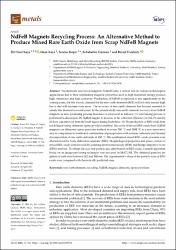NdFeB Magnets recycling process: an alternative method to produce mixed rare earth oxide from Scrap NdFeB Magnets
Künye
Kaya, E. E., Kaya, O., Stopic, S., Gürmen, S., & Friedrich, B. (2021). NdFeB Magnets Recycling Process: An Alternative Method to Produce Mixed Rare Earth Oxide from Scrap NdFeB Magnets. Metals, 11(5), 716.Özet
Neodymium iron boron magnets (NdFeB) play a critical role in various technological applications due to their outstanding magnetic properties, such as high maximum energy product, high remanence and high coercivity. Production of NdFeB is expected to rise significantly in the coming years, for this reason, demand for the rare earth elements (REE) will not only remain high but it also will increase even more. The recovery of rare earth elements has become essential to satisfy this demand in recent years. In the present study rare earth elements recovery from NdFeB magnets as new promising process flowsheet is proposed as follows; (1) acid baking process is performed to decompose the NdFeB magnet to increase in the extraction efficiency for Nd, Pr, and Dy. (2) Iron was removed from the leach liquor during hydrolysis. (3) The production of REE-oxide from leach liquor using ultrasonic spray pyrolysis method. Recovery of mixed REE-oxide from NdFeB magnets via ultrasonic spray pyrolysis method between 700 degrees C and 1000 degrees C is a new innovative step in comparison to traditional combination of precipitation with sodium carbonate and thermal decomposition of rare earth carbonate at 850 degrees C. The synthesized mixed REE- oxide powders were characterized by X-ray diffraction analysis (XRD). Morphological properties and phase content of mixed REE- oxide were revealed by scanning electron microscopy (SEM) and Energy-dispersive X-ray (EDX) analysis. To obtain the size and particle size distribution of REE-oxide, a search algorithm based on an image-processing technique was executed in MATLAB. The obtained particles are spherical with sizes between 362 and 540 nm. The experimental values of the particle sizes of REE- oxide were compared with theoretically predicted ones.

















